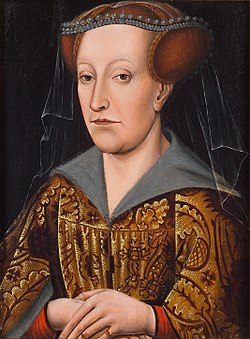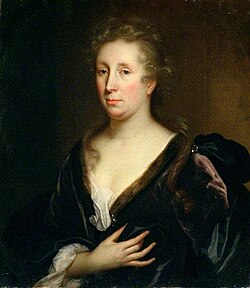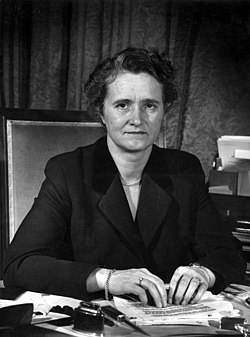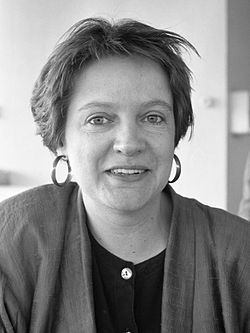| Name | Lived |
|---|
| Trijn van Leemput | ca. 1530–1607 |
| Mies Boissevain-van Lennep | 1896-1965 |
| Wilhelmina Drucker | 1847-1925 |
| Katharina Lescailje | 1649-1711 |
| Judith Leyster | 1609-1660 |
| Johanna Dorothea Lindenaer | 1664-1737? |
| Aefgen Listincx | d. 1535 |
| Charlotta Elisabeth van der Lith | 1700-1753 |
| Maria van Lommen | 1688-1742 |
| Mary of Looz-Heinsberg | 1424-1502 |
| Louise Augusta Wilhelmina Amalia van Pruisen | 1808-1870 |
| Louise de Coligny | 1555-1620 |
| Louise Henriette prinses van Oranje | 1627-1667 |
| Louise Hollandine prinses van de Palts | 1622-1709 |
| Louise Juliana prinses van Oranje | 1576-1644 |
| Louise van Oranje-Nassau | 1828-1871 |
| Margaret Cavendish, Duchess of Newcastle-upon-Tyne | 1623?-1673 |
| Magdalena Hermina Lulofs | 1899-1958 |
| Emilie Marguérite Luzac | 1748-1788 |
| Adriana Maas | 1702-1746 |
| Machteld van Brabant | ca. 1200–1267 |
| Margaretha van Beieren | 1363-1424 |
| Margaretha van Bourgondië | 1374-1441 |
| Margaretha van Holland | 1234-1276 |
| Margaretha van Oostenrijk | 1480-1530 |
| Margaretha van Parma | 1522-1586 |
| Margaretha van York | 1446-1503 |
| Maria Henrietta Stuart I | 1631-1661 |
| Maria Louise van Hessen-Kassel | 1688-1765 |
| Maria van Nassau (1556–1616) | 1556-1616 |
| Maria Stuart II | 1662-1694 |
| Maria van Hongarije (1505-1558) | 1505-1558 |
| Marianne van Oranje-Nassau | 1810-1883 |
| Cornelia van Marle | 1661-1698 |
| Eva van Marle | 1661-1698 |
| Hendrika Wilhelmina Mastenbroek | 1919-2003 |
| Agneta Wilhelmina Johanna Matthes | 1847-1909 |
| Margaretha van Mechelen | ca. 1581–1662 |
| Maria ter Meetelen | 1704-? |
| Conny Stuart | 1913-2010 |
| Maria Sybilla Merian | 1647-1717 |
| Cornelia van der Mijn | 1709-after 1772? |
| Sylvia Millecam | 1956-2001 |
| Petronella Moens | 1762-1843 |
| Maria Moninckx | 1676?-1757 |
| Elisabeth Mooij | 1712-1759 |
| Magdalena Moons | 1541-1613 |
| Catharina Mulder | 1723-1798 |
| Helene Kröller-Müller | 1869-1939 |
| Petronella Muns | 1794-1842 |
| Johanna Paulina Musters | 1878-1895 |
| Gracia Nasi | ca. 1510–1569 |
| Dieuwke IJtje Willemke Nauta | 1930-2008 |
| Henriette Amelie de Nerha | d. 1818 |
| Jacoba Maria van Nickelen | 1680-1749 |
| Blonde Dolly | 1927-1959 |
| Cornelia van Nijenroode | 1629-1692? |
| Mariken van Nimwegen | ca. 1515- |
| Saint Oda | end 7th-1st half 8th century |
| Geertrui van Oosten | ca. 1320–1358 |
| Maria van Oosterwijck | 1630-1693 |
| Catharina Oostfries | 1636?-1708 |
| Willemijntje den Ouden | 1918-1997 |
| Henriette Adriana Louise Flora d' Oultremont de Wégimont | 1792-1864 |
| Magdalena de Passe | 1600-1638 |
| Pauline van Oranje-Nassau | 1800-1806 |
| Henriëtta van Pee | 1692-1741 |
| Thea Beckman | 1923-2004 |
| Petronilla van Saksen | ca. 1082–1144 |
| Plectrudis | d.na 717 |
| Aleid van Poelgeest | ca. 1370–1392 |
| Maria Ponderus | 1672-1764 |
| Bauck Poppema | d. 1501 |
| Catharina Questiers | 1631-1669 |
| Jurjentje Aukes Rauwerda | 1812-1877 |
| Hanna van Recklinghausen | voor 1332-after 1349 |
| Trijntje Johannes Reidinga | 1799-1869 |
| Christina Reinira van Reede | 1776-1847 |
| Trijn Rembrands | ca. 1557–1638 |
| Richardis van Wittelsbach | ca. 1174–1232 |
| Suze Robertson | 1855-1922 |
| Johanna Bordewijk-Roepman | 1892-1971 |
| Geertruydt Roghman | 1625-after 1651 |
| Magdalena Roghman | 1637-after 1669 |
| Catharina Rose | d. after 1587 |
| Sara Rothé | 1699-1751 |
| Katharina Rozee | 1632-1682 |
| Renate Ida Rubinstein | 1929-1990 |
| Audrey Hepburn | 1929-1993 |
| Wilhelmina Jacoba Ruys | 1904-1999 |
| Anna Ruysch | 1666-1754 |
| Rachel Ruysch | 1664-1750 |
| Sara Saftleven | 1645/1650?-1702 |
| Elisabeth Samson | 1715-1771 |
| Margaretha Sandra | 1629-1674 |
| Hannie Schaft | 1920-1945 |
| Maria Schalcken | 1645/1650-v??r 1700 |
| Henriette Roland Holst | 1869-1952 |
| Cornelia Scheffer | 1830-1899 |
| Lidwina van Schiedam | 1380-1433 |
| Annie M.G. Schmidt | 1911-1995 |
| Teddy Scholten | 1926-2010 |
| Maria van Schooten | ca. 1555–1573 |
| Anna Maria van Schurman | 1607-1678 |
| Thérèse Schwartze | 1851-1918 |
| Isabelle de Charrière (Belle van Zuylen) | 1740-1805 |
| Weyn Ockers | d. 1568 |
| Swob Sjaarda | ca. 1435–1520 |
| Johanna Elisabeth Smit | 1933-1981 |
| Sophia van Rheineck | ca. 1115–1176 |
| Sophie Hedwig van Brunswijk-Wolfenbüttel | 1592-1642 |
| Sophie van de Palts | 1630-1714 |
| Sophie van Oranje-Nassau | 1824-1897 |
| Sophie van Württemberg | 1818-1877 |
| Maria van Spanje | 1759?-after 1782 |
| Adriana Spilberg | 1656-after 1697 |
| het Vrouwtje van Stavoren | before 1500 |
| Hendrickje Stoffels | 1626/1627-1663 |
| Maria Swanenburg | 1839-1915 |
| Bartholda van Swieten | 1566-1647 |
| Theophanu | ca. 960–991 |
| Madame Therese | active 1706/1729-? |
| Petronella Johanna de Timmerman | 1723/1724-1786 |
| Alexine Tinne | 1835-1869 |
| Adriana van Tongeren | 1691?-1764 |
| Charley Toorop | 1891-1955 |
| Cornelia Toppen | 1730-1800 |
| Anna Louisa Geertruida Toussaint | 1812-1886 |
| Sara Troost | 1732-1803 |
| Saskia Uylenburgh | 1612-1642 |
| M. Vasalis | 1909-1998 |
| Cornelia van der Veer | 1639-1704 |
| Catharina Jacoba van Velde | 1903-1985 |
| Maria Verelst | 1680-1744 |
| Annie Romein-Verschoor | 1895-1978 |
| Ida Saint-Elme | 1776-1845 |
| Anna Visscher | 1584-1652 |
| Maria Tesselschade Visscher | 1594-1649 |
| Elizabeth Vuijk | 1905-1991 |
| Anna de Waal | 1906-1981 |
| Lucy Walter | 1630-1658 |
| Elisabeth Wandscherer | d. 1535 |
| Elisabeth Geertruida Wassenbergh | 1729-1781 |
| Johanna Cornelia Wattier | 1762-1827 |
| Maria Weenix | 1697-1774 |
| Lia Dorana | 1918-2010 |
| Sophia Maria Westendorp | 1916-2004 |
| Trijntje Pieters Westra | 1783-1861 |
| Maria de Wilde | 1682-1729 |
| Wilhelmina of the Netherlands | 1880-1962 |
| Wilhelmine of Prussia, Queen of the Netherlands | 1774-1837 |
| Wilhelmina of Prussia, Princess of Orange | 1751-1820 |
| Alida Withoos | ca. 1661–1730 |
| Maria Withoos | 1663-after 1699 |
| Jacomina de Witte | 1582-1661 |
| Maria Petronella Woesthoven | 1760-1830 |
| Aleijda Wolfsen | 1648-1692 |
| Margaretha Wulfraet | 1678-1760 |
| Geertje Wyntges | 1636-1712 |
| het Meisje van Yde | na 54 v. C.-voor 128 n. C. |
| Clara de Vries | 1915–1942 |
| Maria van Zuylekom | 1759–1831 |























